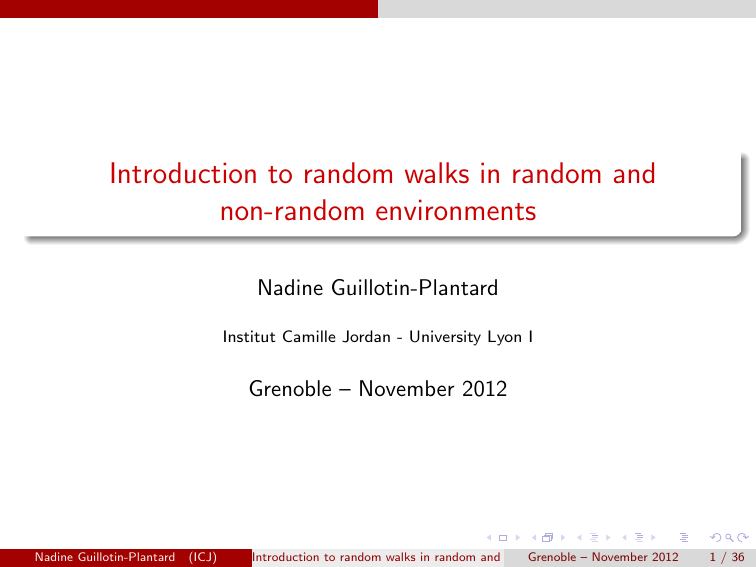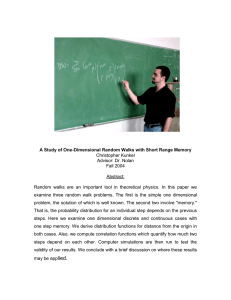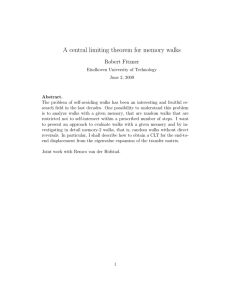Introduction to random walks in random and non
advertisement

Introduction to random walks in random and
non-random environments
Nadine Guillotin-Plantard
Institut Camille Jordan - University Lyon I
Grenoble – November 2012
Nadine Guillotin-Plantard
(ICJ)
Introduction to random walks in random and non-random
Grenobleenvironments
– November 2012
1 / 36
Outline
1
Simple Random Walks in Zd
Definition
Recurrence - Transience
Asymptotic distribution for n large
Asymmetric random walk
2
Random Walks in Random Environments
Definition
Recurrence-Transience
Valleys (or traps) - Slowing down
Asymptotic distributions for n large
3
Random Walk in Random Scenery
Nadine Guillotin-Plantard
(ICJ)
Introduction to random walks in random and non-random
Grenobleenvironments
– November 2012
2 / 36
Simple Random Walks in Zd
Definition
At time 0, a walker starts from the site 0, tosses a coin. If he gets ”Head”,
then he goes to the site +1, otherwise to the site -1. (”Tail”)
Nadine Guillotin-Plantard
(ICJ)
Introduction to random walks in random and non-random
Grenobleenvironments
– November 2012
3 / 36
Simple Random Walks in Zd
Nadine Guillotin-Plantard
(ICJ)
Definition
Introduction to random walks in random and non-random
Grenobleenvironments
– November 2012
4 / 36
Simple Random Walks in Zd
Definition
Natural questions
Does the walker come back to the origin ?
Notion of Recurrence - Transience.
Mean position of the walker, fluctuations around this position, large
deviations...
Probability that the walker be at site x at time n
(Local limit theorem)
Number of distinct sites visited by the walker up to time n (Range)
Maximal (or minimal) position of the walker before time n
Number of visits to a fixed site x. (Local time )
The last time the random walker visits 0 before time n
The number of positive values of the random walk before time n
Number of self-intersections up to time n.
Favorite sites of the walker
and so on...
Nadine Guillotin-Plantard
(ICJ)
Introduction to random walks in random and non-random
Grenobleenvironments
– November 2012
5 / 36
Simple Random Walks in Zd
Definition
Let (Xi )i≥1 be i.i.d. random variables taking values +1 or −1 with equal
probability.
{Xi = +1} ={ The walker gets ”Head” at time i}.
The position of the walker at time n is given by :
S0 := 0
and for any n ≥ 1,
Sn :=
n
X
Xi
i=1
(Sn )n≥0 is called simple random walk on Z.
From this writing, we can compute
E (Sn ) = 0
and Var (Sn ) = E (Sn2 ) = n. Therefore, Sn ∼
Nadine Guillotin-Plantard
(ICJ)
√
n
Introduction to random walks in random and non-random
Grenobleenvironments
– November 2012
6 / 36
Simple Random Walks in Zd
Recurrence - Transience
For n integer,
P(S2n = 0) =
=
=
∼
Number of paths of length 2n from 0 to 0
Number of paths of length 2n
n
C2n
22n
(2n)!
4n (n!)2
1
√
for n large
πn
using Stirling’s formula
n! ∼
Nadine Guillotin-Plantard
(ICJ)
n n √
e
2πn.
Introduction to random walks in random and non-random
Grenobleenvironments
– November 2012
7 / 36
Simple Random Walks in Zd
Recurrence - Transience
A random walk is said recurrent iff
h
i
h
i
P lim sup {Sn = 0} = P Sn = 0 i.o. = 1
n
Otherwise, it is called transient. Since Sn is a Markov chain, we have this
useful criterion :
Theorem
(Sn )n is recurrent iff
+∞
X
P(Sn = 0) = +∞
n=0
√
Since P(Sn = 0) ∼ C / n, the simple random walk on Z is recurrent.
Nadine Guillotin-Plantard
(ICJ)
Introduction to random walks in random and non-random
Grenobleenvironments
– November 2012
8 / 36
Simple Random Walks in Zd
Recurrence - Transience
Simple random walk in Z2
Simple random walk in Z2
Nadine Guillotin-Plantard
(ICJ)
Introduction to random walks in random and non-random
Grenobleenvironments
– November 2012
9 / 36
Simple Random Walks in Zd
Recurrence - Transience
Georges Pólya (1887 – 1985)
Nadine Guillotin-Plantard
(ICJ)
Introduction to random walks in random and non-random
Grenoble –environments
November 2012
10 / 36
Simple Random Walks in Zd
Recurrence - Transience
In higher dimension
Theorem (Pólya (1921) )
There exists some constant C = C (d) s.t. for n large enough
P(Sn = 0) ∼ C n−d/2 .
Main tool: Fourier Inversion Formula
Z
1
E (e iΘ·Sn )dΘ
P(Sn = 0) =
(2π)d [−π,π]d
Use that Sn is a sum of i.i.d. random vectors and for ||Θ|| small,
E (e iΘ·X1 ) = 1 −
Nadine Guillotin-Plantard
(ICJ)
||Θ||2
+ o(||Θ||2 )
2d
Introduction to random walks in random and non-random
Grenoble –environments
November 2012
11 / 36
Simple Random Walks in Zd
Recurrence - Transience
Theorem
A simple random walk in Zd is recurrent for d = 1 or 2, but is transient
for d ≥ 3.
Another way to say that :
”All roads lead to Rome except the cosmic paths ! ”
Nadine Guillotin-Plantard
(ICJ)
Introduction to random walks in random and non-random
Grenoble –environments
November 2012
12 / 36
Simple Random Walks in Zd
Asymptotic distribution for n large
Local limit theorem
For n and x integers s.t. n + x is even,
P(Sn = x) =
Number of paths of length n from 0 to x
Number of paths of length n
(n+x)/2
=
Cn
2n
x2
2 e − 2n
∼
. √
for n large and |x| = o(n2/3 )
π
n
√
Therefore, for any x ∈ R s.t. n + [x n] is even,
r
√
P(Sn = [x n]) ∼
Nadine Guillotin-Plantard
(ICJ)
r
x2
2 e− 2
. √
π
n
for n large
Introduction to random walks in random and non-random
Grenoble –environments
November 2012
13 / 36
Simple Random Walks in Zd
Let a, b ∈ R with a < b,
√
√ P S2n ∈ [a 2n, b 2n]
Asymptotic distribution for n large
X
=
√
P(S2n = k)
√
k∈[a 2n,b 2n]
r
∼
2
n
m2
1
√ e− 2
2π
X
m∈[a,b]∩ √2Z
2n
→
1
√
2π
Z
b
e
2
− x2
dx = P(X ∈ [a, b])
a
where X is distributed as the Normal distribution N (0, 1).
Notation: As n tends to infinity,
S
L
√n −→ N (0, 1).
n
Nadine Guillotin-Plantard
(ICJ)
Introduction to random walks in random and non-random
Grenoble –environments
November 2012
14 / 36
Simple Random Walks in Zd
Asymptotic distribution for n large
Maximum of the path at time n
Define
Mn :=
=
max Sk
k=0..n
max S[nt]
t∈[0,1]
For any t > 0, as n large,
S[nt]
√
n
∼ N (0, t) and
M
√ n = max
n t∈[0,1]
S[nt]
√
n
Functional of the path from 0 to time n, a convergence in distribution on
the space of the càd-làg paths (φ(t))t∈[0,1] is needed.
Nadine Guillotin-Plantard
(ICJ)
Introduction to random walks in random and non-random
Grenoble –environments
November 2012
15 / 36
Simple Random Walks in Zd
Nadine Guillotin-Plantard
(ICJ)
Asymptotic distribution for n large
Introduction to random walks in random and non-random
Grenoble –environments
November 2012
16 / 36
Simple Random Walks in Zd
Asymptotic distribution for n large
Functional limit theorem
The sequence
S[nt]
√
n
t≥0
converges in law to the real Brownian motion
(Bt )t≥0 , that is a stochastic process satisfying :
B0 := 0
Stationarity of the increments : Bt − Bs ∼ Bt−s for s < t
Independence of the increments : Bt − Bs independent from Bs
Bt ∼ N (0, t)
The law of the maximum of the Brownian motion is well-known :
max Bt ∼ B1 ∼ N (0, 1)
t∈[0,1]
Nadine Guillotin-Plantard
(ICJ)
Introduction to random walks in random and non-random
Grenoble –environments
November 2012
17 / 36
Simple Random Walks in Zd
Asymptotic distribution for n large
Arcsine distributions
With the same method, we can compute the asymptotic distributions of
many functionals of the random walk :
Nn = max{k = 1 . . . n ; Sk = 0} the last time the random walker
visits 0 before time n
Vn = #{k = 1 . . . n ; Sk > 0} the number of positive values of the
random walk before time n
We have for any x ∈ (0, 1), as n is large,
P(Nn ≤ xn) ∼
√
2
arcsin( x)
π
P(Vn ≤ xn) ∼
√
2
arcsin( x).
π
and
Nadine Guillotin-Plantard
(ICJ)
Introduction to random walks in random and non-random
Grenoble –environments
November 2012
18 / 36
Simple Random Walks in Zd
Nadine Guillotin-Plantard
(ICJ)
Asymptotic distribution for n large
Introduction to random walks in random and non-random
Grenoble –environments
November 2012
19 / 36
Simple Random Walks in Zd
Asymmetric random walk
The random walker moves to the right with probability p and to the left
with probability q = 1 − p.
Same questions as before: Recurrence, Transience, Asymptotic
distribution,....
Nadine Guillotin-Plantard
(ICJ)
Introduction to random walks in random and non-random
Grenoble –environments
November 2012
20 / 36
Simple Random Walks in Zd
Asymmetric random walk
Let (Xi )i≥1 be i.i.d. random variables taking values +1 or −1 with
probability p and q = 1 − p respectively. The position of the walker at
time n is given by :
S0 := 0
and for any n ≥ 1,
Sn :=
n
X
Xi
i=1
From this writing, we can compute
E (X1 ) = p − q 6= 0
The strong law of large numbers gives : as n → +∞,
n
Sn
1X
=
Xi → E (X1 ) = p − q a.s.
n
n
i=1
The random walk (Sn )n is transient, tends to +∞ (resp. −∞) when
p > q (resp. p < q).
Nadine Guillotin-Plantard
(ICJ)
Introduction to random walks in random and non-random
Grenoble –environments
November 2012
21 / 36
Simple Random Walks in Zd
Asymmetric random walk
Asymptotic distribution for n large
As n → +∞,
Sn − n (p − q) L
√
−→ N (0, σ 2 )
n
where σ 2 = 4p(1 − p).
Indeed, for n integer and x ∈ Z s.t. n + x is even,
(n+x)/2 (n+x)/2 (n−x)/2
P(Sn = x) = Cn
p
q
∼ ....
Nadine Guillotin-Plantard
(ICJ)
Introduction to random walks in random and non-random
Grenoble –environments
November 2012
22 / 36
Random Walks in Random Environments
Definition
Random Environment : Let ωx , x ∈ Z, be i.i.d. random variables with
values in [0, 1], uniformly bounded away from 0 and 1.
For a given realization of the environment, we consider the Markov chain
(Sn )n which jumps to the site x + 1, with probability ωx and to x − 1 with
probability 1 − ωx , given it is located at x.
They were introduced by A.A. Chernov in 1967 in order to model the
replication of DNA.
Nadine Guillotin-Plantard
(ICJ)
Introduction to random walks in random and non-random
Grenoble –environments
November 2012
23 / 36
Random Walks in Random Environments
Definition
Quenched law: Denote by Pω the law of the walk (starting from 0)
in the environment ω.
Annealed law: If P denotes the law of the environment,
P = P × Pω
defined as
Z
P(.) =
Pω (.) dP(ω)
Fundamental remark :
Under P, the random walk is not a Markov chain.
(Under Pω , the random walk is a Markov chain (inhomogeneous in space))
Nadine Guillotin-Plantard
(ICJ)
Introduction to random walks in random and non-random
Grenoble –environments
November 2012
24 / 36
Random Walks in Random Environments
Recurrence-Transience
Solomon I
The ratio
ρx :=
1 − ωx
ωx
plays an important role in the study of RWRE.
Theorem (Solomon (1975))
If E(ln ρ0 ) < 0 (resp. > 0) then the random walk is transient and
lim Sn = +∞ (resp − ∞) P − a.s.
n→+∞
If E(ln ρ0 ) = 0, then the random walk is recurrent and
lim sup Sn = +∞ and lim inf Sn = −∞ P − a.s.
n→+∞
Nadine Guillotin-Plantard
(ICJ)
n→+∞
Introduction to random walks in random and non-random
Grenoble –environments
November 2012
25 / 36
Random Walks in Random Environments
Recurrence-Transience
Solomon II
Theorem (Solomon (1975))
P-almost surely,
Sn
=v
n→+∞ n
lim
where
v=
1−E(ρ0 )
1+E(ρ0 )
E(1/ρ0 )−1
E(1/ρ0 )+1
0
if
E(ρ0 ) < 1
if
if
1 < 1/E(ρ−1
0 )
−1
1/E(ρ0 ) ≤ 1 ≤ E(ρ0 )
Comparison with the random walk in Z:
1- |v | < |E(S1 )| −→ some slowdown already occurs.
2- The random walk can be transient with zero speed !
Nadine Guillotin-Plantard
(ICJ)
Introduction to random walks in random and non-random
Grenoble –environments
November 2012
26 / 36
Random Walks in Random Environments
Potential:
V (x) =
x
X
Valleys (or traps) - Slowing down
if
x ≥1
0
if
0
X
log(ρk ) if
−
x =0
log(ρk )
k=1
x ≤ −1
k=x+1
(V (x))x is a real random walk with mean E[log ρ0 ] and variance
E[(log ρ0 )2 ].
Remark also that
1
e −V (x)
>
ωx = −V (x−1)
−V
(x)
2
e
+e
if and only if
V (x − 1) > V (x).
When the potential decreases (resp. increases), the random walker tends
to go to the right (resp. left).
Nadine Guillotin-Plantard
(ICJ)
Introduction to random walks in random and non-random
Grenoble –environments
November 2012
27 / 36
Random Walks in Random Environments
Nadine Guillotin-Plantard
(ICJ)
Valleys (or traps) - Slowing down
Introduction to random walks in random and non-random
Grenoble –environments
November 2012
28 / 36
Random Walks in Random Environments
Nadine Guillotin-Plantard
(ICJ)
Valleys (or traps) - Slowing down
Introduction to random walks in random and non-random
Grenoble –environments
November 2012
29 / 36
Random Walks in Random Environments
Asymptotic distributions for n large
Recurrent case – E[log ρ0 ] = 0
Theorem (Sinai (1982), Kesten (1986), Golosov (1986))
Denote
σ 2 = E(log ρ0 )2 ∈ ]0, +∞[
Then,
σ2
L
Sn −→ b∞
2
(log n)
where b∞ is a symmetric random variable with Laplace transform
√
cosh( 2λ) − 1
−λ|b∞ |
√
E(e
)=
, λ > 0.
λ cosh( 2λ)
Nadine Guillotin-Plantard
(ICJ)
Introduction to random walks in random and non-random
Grenoble –environments
November 2012
30 / 36
Random Walks in Random Environments
Asymptotic distributions for n large
Transient case – E[log ρ0 ] < 0
Under both assumptions :
1- There exists κ > 0 s.t. E(ρκ0 ) = 1 and E(ρκ0 (log ρ0 )+ ) < ∞.
2- The distribution of log(ρ0 ) is non-lattice.
Theorem (Kesten-Kozlov-Spitzer (1975))
When κ < 1, (v = 0)
lim P
n→+∞
S
n
nκ
≤ x = 1 − Lκ,b (x −1/κ )
When κ ∈ (1, 2),
lim P
n→+∞
Nadine Guillotin-Plantard
(ICJ)
S − nv
n
≤
x
= 1 − Lκ,b (−x).
v 1+1/κ n1/κ
Introduction to random walks in random and non-random
Grenoble –environments
November 2012
31 / 36
Random Walks in Random Environments
Asymptotic distributions for n large
Transient case – E[log ρ0 ] < 0
Lκ,b is a stable distribution with characteristic function
t
κ
L̂κ,b (t) = exp −b|t| 1 − i tan(πκ/2)
|t|
The value of b for κ ∈ (0, 2) was determined by Enriquez, Sabot and
Zindy (’09)
Theorem (Kesten-Kozlov-Spitzer (1975))
When κ > 2,
Sn − nv L
√
−→ N (0, σ 2 )
n
where σ 2 > 0.
Nadine Guillotin-Plantard
(ICJ)
Introduction to random walks in random and non-random
Grenoble –environments
November 2012
32 / 36
Random Walk in Random Scenery
Riddle
Is this random walk recurrent or transient ?
Nadine Guillotin-Plantard
(ICJ)
Introduction to random walks in random and non-random
Grenoble –environments
November 2012
33 / 36
Random Walk in Random Scenery
Theorem (Campanino – Pétritis (2003))
The random walk (Sn )n is transient for almost every realization of the
orientations.
A local limit theorem can even be proved.
Theorem (Castell – Guillotin-Plantard – Pène – Schapira (AOP, 2011))
For n large,
P[Sn = 0] ∼
Nadine Guillotin-Plantard
(ICJ)
C
.
n5/4
Introduction to random walks in random and non-random
Grenoble –environments
November 2012
34 / 36
Random Walk in Random Scenery
(Sn )n has the same distribution as (Xn , Yn )n where
Yn is the ”blue” random walk on Z.
Xn is the random walk (Yn ) in random scenery (”H”, ”T ”) :
ξi = 1 (resp. −1) if ”Tail” (resp. ”Head”) at site i ∈ Z,
Xn =
n−1
X
ξY k
k=0
Nadine Guillotin-Plantard
(ICJ)
Introduction to random walks in random and non-random
Grenoble –environments
November 2012
35 / 36
Random Walk in Random Scenery
We have
P[Sn = 0] = P[Xn = 0; Yn = 0]
∼ P[Xn = 0|Yn = 0]P[Yn = 0]
We know that
P[Yn = 0] ∼
C
n1/2
and (not easy !)
P[Xn = 0|Yn = 0] ∼
Nadine Guillotin-Plantard
(ICJ)
C
n3/4
Introduction to random walks in random and non-random
Grenoble –environments
November 2012
36 / 36





